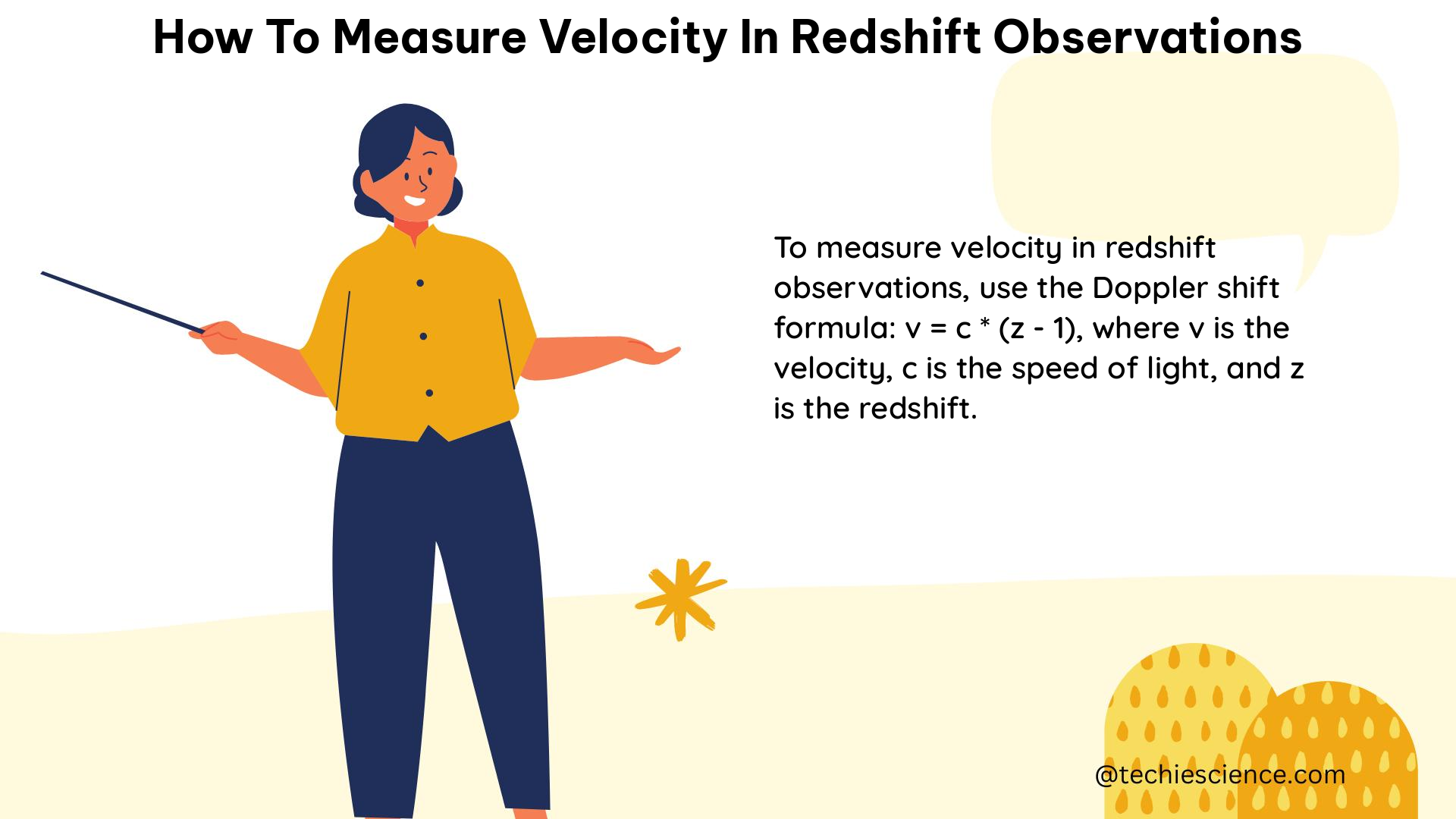Summary
Measuring the velocity of distant galaxies through redshift observations is a fundamental technique in modern astrophysics. By understanding the Doppler effect and applying the appropriate formulas, astronomers can determine the recession velocities of these celestial objects, providing crucial insights into the expansion of the universe. This comprehensive guide delves into the technical details, formulas, and practical applications of this essential skill, equipping physics students with the knowledge to accurately measure velocities in redshift observations.
Understanding the Doppler Effect

The Doppler effect is the key principle underlying the measurement of velocity in redshift observations. When a light source is moving away from an observer, the wavelength of the light is shifted towards longer, or “redder,” wavelengths. This shift in wavelength is directly proportional to the velocity of the object, as described by the formula:
Δλ/λ = v/c
Where:
– Δλ is the change in wavelength
– λ is the original wavelength
– v is the velocity of the object
– c is the speed of light
This ratio of the change in wavelength to the original wavelength is known as the redshift, denoted by the symbol z.
Calculating Redshift and Velocity
To measure the velocity of a galaxy using redshift observations, follow these steps:
- Identify a well-defined spectral line in the galaxy’s spectrum, such as a Balmer series hydrogen line.
- Determine the rest wavelength (λ₀) of the chosen spectral line, which is the wavelength of the line when the source is at rest.
- Measure the observed wavelength (λ) of the spectral line in the galaxy’s spectrum.
- Calculate the redshift (z) using the formula:
z = (λ – λ₀) / λ₀ - Convert the redshift to velocity (v) using the formula:
v = c * z
Where c is the speed of light, approximately 300,000 km/s.
For example, if a hydrogen Balmer line is observed at 5050 Å in the spectrum of a galaxy, and the rest wavelength of that line is 5000 Å, the redshift and velocity can be calculated as follows:
z = (5050 Å – 5000 Å) / 5000 Å = 0.01
v = c * z = 300,000 km/s * 0.01 = 3,000 km/s
This means the galaxy is receding from us at a velocity of 3,000 km/s.
Limitations and Considerations
It’s important to note that the simple formula v = c * z is only accurate when the redshift z is small compared to 1. For high-velocity objects, where z approaches 1, a more complex formula based on Einstein’s Special Theory of Relativity is required:
v = c * (z / (1 + z))
Additionally, it’s crucial to use well-defined spectral lines with known rest wavelengths when measuring redshift. The Balmer series of hydrogen lines is a common choice, as they are easily reproduced in the laboratory and have the same spectral pattern in distant galaxies.
Another important consideration is that the “motion” of galaxies is not through space, but rather the expansion of space itself. Galaxies are not moving through a static background; instead, they are being carried along by the expansion of the universe, as described by the Hubble law.
Practical Applications and Implications
Measuring velocities through redshift observations has numerous applications in astrophysics and cosmology, including:
-
Hubble’s Law and the Expansion of the Universe: The relationship between a galaxy’s redshift and its distance, known as Hubble’s law, provides evidence for the expansion of the universe and allows for the determination of the Hubble constant, a crucial parameter in cosmological models.
-
Mapping the Large-Scale Structure of the Universe: Redshift measurements of galaxies, combined with their positions on the sky, enable the construction of three-dimensional maps of the large-scale structure of the universe, revealing the distribution of matter and the evolution of cosmic structures.
-
Studying the Dynamics of Galaxy Clusters: Redshift measurements of individual galaxies within a cluster can be used to determine the cluster’s overall velocity distribution, providing insights into the cluster’s mass, gravitational potential, and dark matter content.
-
Probing the Early Universe: Observations of high-redshift galaxies, corresponding to objects seen at earlier stages of the universe’s history, offer a window into the conditions and processes that shaped the early cosmos.
-
Testing Cosmological Models: Precise measurements of redshifts and velocities, combined with other observational data, allow for the testing and refinement of cosmological models, such as the standard Lambda-CDM model, which describes the evolution and composition of the universe.
Conclusion
Mastering the techniques for measuring velocity in redshift observations is a crucial skill for physics students interested in astrophysics and cosmology. By understanding the Doppler effect, applying the appropriate formulas, and considering the limitations and practical applications of this method, students can contribute to the ongoing exploration and understanding of the universe’s structure, evolution, and fundamental properties.
References
- Hubble, E. (1929). A relation between distance and radial velocity among extra-galactic nebulae. Proceedings of the National Academy of Sciences, 15(3), 168-173.
- Peebles, P. J. E. (1993). Principles of Physical Cosmology. Princeton University Press.
- Ryden, B. (2017). Introduction to Cosmology (2nd ed.). Cambridge University Press.
- Weinstock, H. (1972). Redshift and the Doppler effect. American Journal of Physics, 40(7), 1047-1051.
- Weinstock, H. (1974). Relativistic Doppler effect. American Journal of Physics, 42(8), 712-717.

The lambdageeks.com Core SME Team is a group of experienced subject matter experts from diverse scientific and technical fields including Physics, Chemistry, Technology,Electronics & Electrical Engineering, Automotive, Mechanical Engineering. Our team collaborates to create high-quality, well-researched articles on a wide range of science and technology topics for the lambdageeks.com website.
All Our Senior SME are having more than 7 Years of experience in the respective fields . They are either Working Industry Professionals or assocaited With different Universities. Refer Our Authors Page to get to know About our Core SMEs.